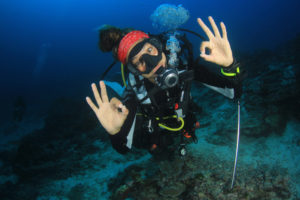It’s no secret that scuba diving isn’t the most glamorous sport. Those of us with long hair tend to look even more disheveled on a dive, and especially when surfacing. Here are some of our favorite tips to help you take control of your diving mane and keep you from surfacing with an Einstein-esque head of hair.
Braids

French braids, double braids, or our personal favorite: diving-princess hair. This small, half French braid starts slightly off-center of your forehead, runs down the side of your head and then ends up in a ponytail that you can also braid. It sounds a bit complicated, but it makes us feel a bit like Xena, Warrior Princess. Regardless of how complex or simple you want to go, braids the best way to keep your locks under control underwater.
Reef-safe conditioners
Leave-in conditioners and coconut oil are good ways to keep your hair moisturized and limit the damage from salt water and sun. Add a good amount to your hair and comb it through before your dive. After the dive(s), try to rinse your hair with fresh water as soon as possible and add a small amount of leave-in conditioner to your hair. To protect the underwater environment, make sure to use reef-safe products. Some of the best are made by Stream2Sea, our go-to for eco-conscious products.
Hoods and Buffs

For a little bit of added control, use a hood or buff to keep your tresses from tangling while in the water. Make sure your hood is not too tight and that you won’t overheat on warm days. Buffs are good alternatives if you’re diving in warm conditions. They also come in handy on the boat, especially on windy boat rides to and from the dive site. You may need to secure them with bobby pins though, as they tend to slide off mid-dive.
Neoprene mask straps
Silicone mask straps often stick to your hair, leaving it tangled and broken. Neoprene mask straps are a good alternative. Some attach to your mask with Velcro, however — a notorious hair-tangler in and of itself. Rather, choose a neoprene mask strap cover. They slip over the silicone mask strap, making your mask strap easier to put on and take off while protecting your hair at the same time.
The magic of detangling brushes
A detangling brush is a must for any diver with long locks. They are usually made of plastic (yes, we know) with bristles that vary in length. We are not sure exactly how it works, but it’s absolute magic for post-dive tangled hair.
While your hair obviously isn’t your first concern when diving, keeping it out of your face can make a dive all the more enjoyable. We hope that these tips on taming your diving mane help just a little bit to let your inner mermaid shine through.

